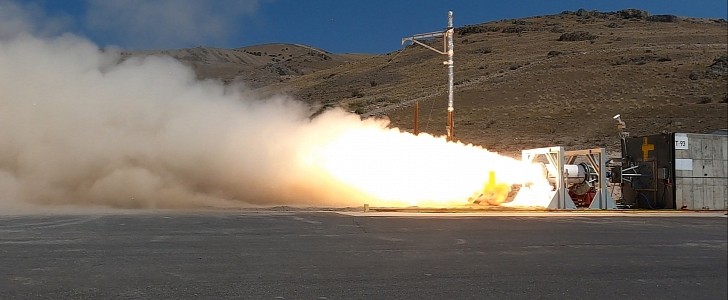On August 25th, the U.S. Navy's Strategic Systems Program has successfully conducted a test of the Second Stage Solid Rocket Motor (SRM) in Promontory, Utah. The ground test marks a step toward the development of the common hypersonic missile that will be fielded by the Navy and the Army.
Back in May, the U.S. Navy successfully tested the first stage of the rocket motor, and now, only three months later, the second stage SRM has passed its first live fire test with flying colors. Both tests are a key component in the development of a Navy-designed common hypersonic missile that will be used by the Navy and the Army and will be capable of flying at speeds that can range between Mach 5 and Mach 10.
Hypersonic weapons that can travel at speeds at least five times the speed of sound are extremely maneuverable and can function at different altitudes. This way, warfighters will be able to defeat high-value targets from hundreds or even thousands of miles away in a matter of minutes. As a result, one of the Department of Defense's top objectives is delivering these hypersonic weapons.
The second stage SRM that was recently tested will be part of a new missile booster, and it will be coupled with a Common Hypersonic Glide Body (CHGB) to form the common hypersonic missile. Each service will employ the same hypersonic missile while building unique weapon systems and launchers that will be used from the sea or land.
This live-fire test represents a significant step toward the next set of combined Navy-Army flight tests, which will result in the deployment of the Conventional Prompt Strike (CPS) and Long Range Hypersonic Weapon (LRHW) missile systems.
The data obtained from these and future tests will help the services build offensive hypersonic technology. In the early to mid-2020s, the Department of Defense plans to develop hypersonic warfighting capabilities in collaboration with academia, government national laboratories, and industry.
Hypersonic weapons that can travel at speeds at least five times the speed of sound are extremely maneuverable and can function at different altitudes. This way, warfighters will be able to defeat high-value targets from hundreds or even thousands of miles away in a matter of minutes. As a result, one of the Department of Defense's top objectives is delivering these hypersonic weapons.
The second stage SRM that was recently tested will be part of a new missile booster, and it will be coupled with a Common Hypersonic Glide Body (CHGB) to form the common hypersonic missile. Each service will employ the same hypersonic missile while building unique weapon systems and launchers that will be used from the sea or land.
This live-fire test represents a significant step toward the next set of combined Navy-Army flight tests, which will result in the deployment of the Conventional Prompt Strike (CPS) and Long Range Hypersonic Weapon (LRHW) missile systems.
The data obtained from these and future tests will help the services build offensive hypersonic technology. In the early to mid-2020s, the Department of Defense plans to develop hypersonic warfighting capabilities in collaboration with academia, government national laboratories, and industry.






